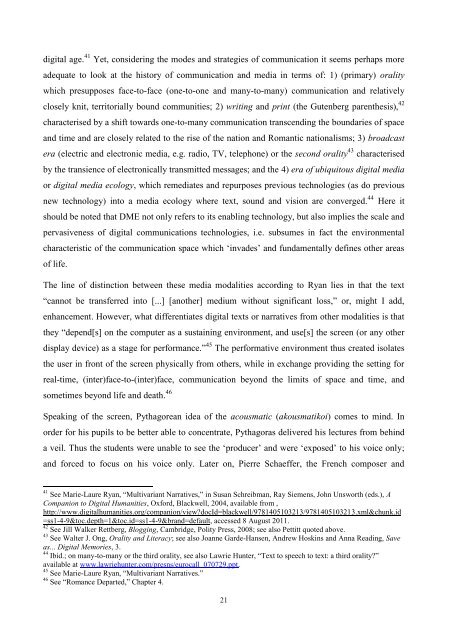UNIVERSITY OF NOVA GORICA GRADUATE SCHOOL ...
UNIVERSITY OF NOVA GORICA GRADUATE SCHOOL ...
UNIVERSITY OF NOVA GORICA GRADUATE SCHOOL ...
Create successful ePaper yourself
Turn your PDF publications into a flip-book with our unique Google optimized e-Paper software.
digital age. 41 Yet, considering the modes and strategies of communication it seems perhaps more<br />
adequate to look at the history of communication and media in terms of: 1) (primary) orality<br />
which presupposes face-to-face (one-to-one and many-to-many) communication and relatively<br />
closely knit, territorially bound communities; 2) writing and print (the Gutenberg parenthesis), 42<br />
characterised by a shift towards one-to-many communication transcending the boundaries of space<br />
and time and are closely related to the rise of the nation and Romantic nationalisms; 3) broadcast<br />
era (electric and electronic media, e.g. radio, TV, telephone) or the second orality 43 characterised<br />
by the transience of electronically transmitted messages; and the 4) era of ubiquitous digital media<br />
or digital media ecology, which remediates and repurposes previous technologies (as do previous<br />
new technology) into a media ecology where text, sound and vision are converged. 44 Here it<br />
should be noted that DME not only refers to its enabling technology, but also implies the scale and<br />
pervasiveness of digital communications technologies, i.e. subsumes in fact the environmental<br />
characteristic of the communication space which ‗invades‘ and fundamentally defines other areas<br />
of life.<br />
The line of distinction between these media modalities according to Ryan lies in that the text<br />
―cannot be transferred into [...] [another] medium without significant loss,‖ or, might I add,<br />
enhancement. However, what differentiates digital texts or narratives from other modalities is that<br />
they ―depend[s] on the computer as a sustaining environment, and use[s] the screen (or any other<br />
display device) as a stage for performance.‖ 45 The performative environment thus created isolates<br />
the user in front of the screen physically from others, while in exchange providing the setting for<br />
real-time, (inter)face-to-(inter)face, communication beyond the limits of space and time, and<br />
sometimes beyond life and death. 46<br />
Speaking of the screen, Pythagorean idea of the acousmatic (akousmatikoi) comes to mind. In<br />
order for his pupils to be better able to concentrate, Pythagoras delivered his lectures from behind<br />
a veil. Thus the students were unable to see the ‗producer‘ and were ‗exposed‘ to his voice only;<br />
and forced to focus on his voice only. Later on, Pierre Schaeffer, the French composer and<br />
41 See Marie-Laure Ryan, ―Multivariant Narratives,‖ in Susan Schreibman, Ray Siemens, John Unsworth (eds.), A<br />
Companion to Digital Humanities, Oxford, Blackwell, 2004, available from ,<br />
http://www.digitalhumanities.org/companion/view?docId=blackwell/9781405103213/9781405103213.xml&chunk.id<br />
=ss1-4-9&toc.depth=1&toc.id=ss1-4-9&brand=default, accessed 8 August 2011.<br />
42 See Jill Walker Rettberg, Blogging, Cambridge, Polity Press, 2008; see also Pettitt quoted above.<br />
43 See Walter J. Ong, Orality and Literacy; see also Joanne Garde-Hansen, Andrew Hoskins and Anna Reading, Save<br />
as... Digital Memories, 3.<br />
44 Ibid.; on many-to-many or the third orality, see also Lawrie Hunter, ―Text to speech to text: a third orality?‖<br />
available at www.lawriehunter.com/presns/eurocall_070729.ppt.<br />
45 See Marie-Laure Ryan, ―Multivariant Narratives.‖<br />
46 See ―Romance Departed,‖ Chapter 4.<br />
21

















